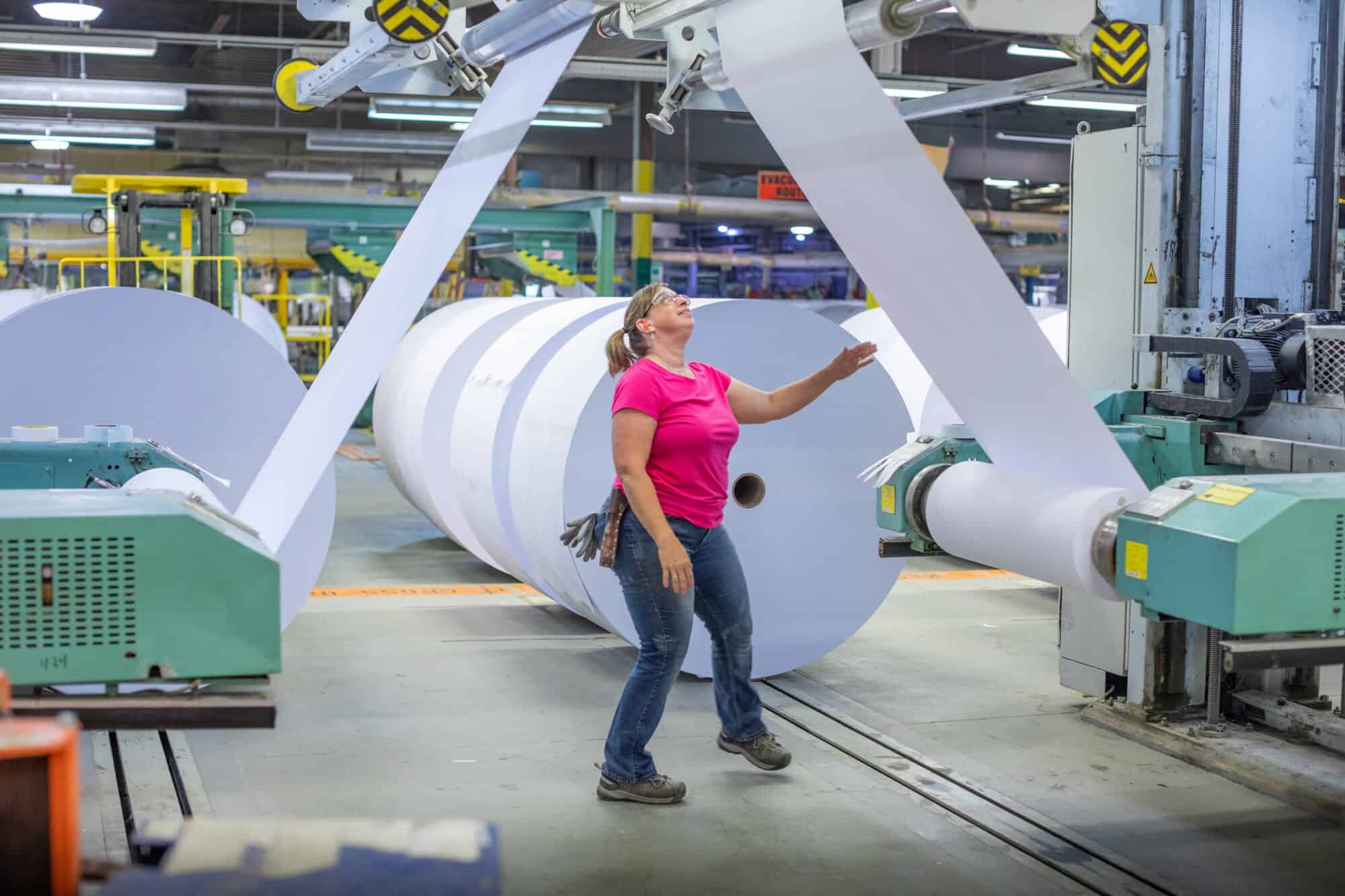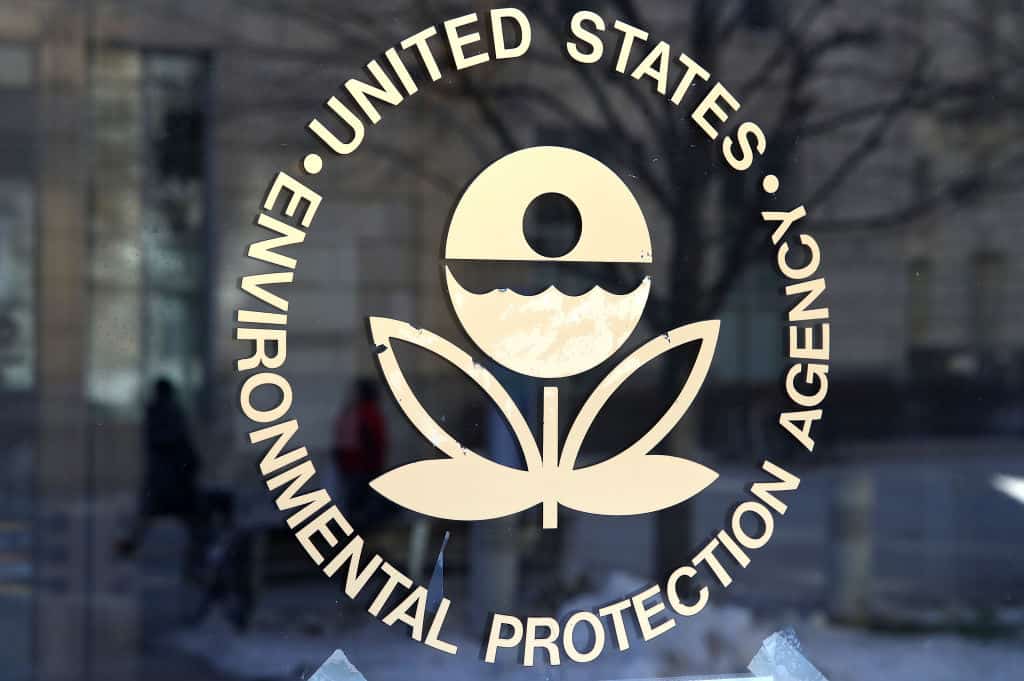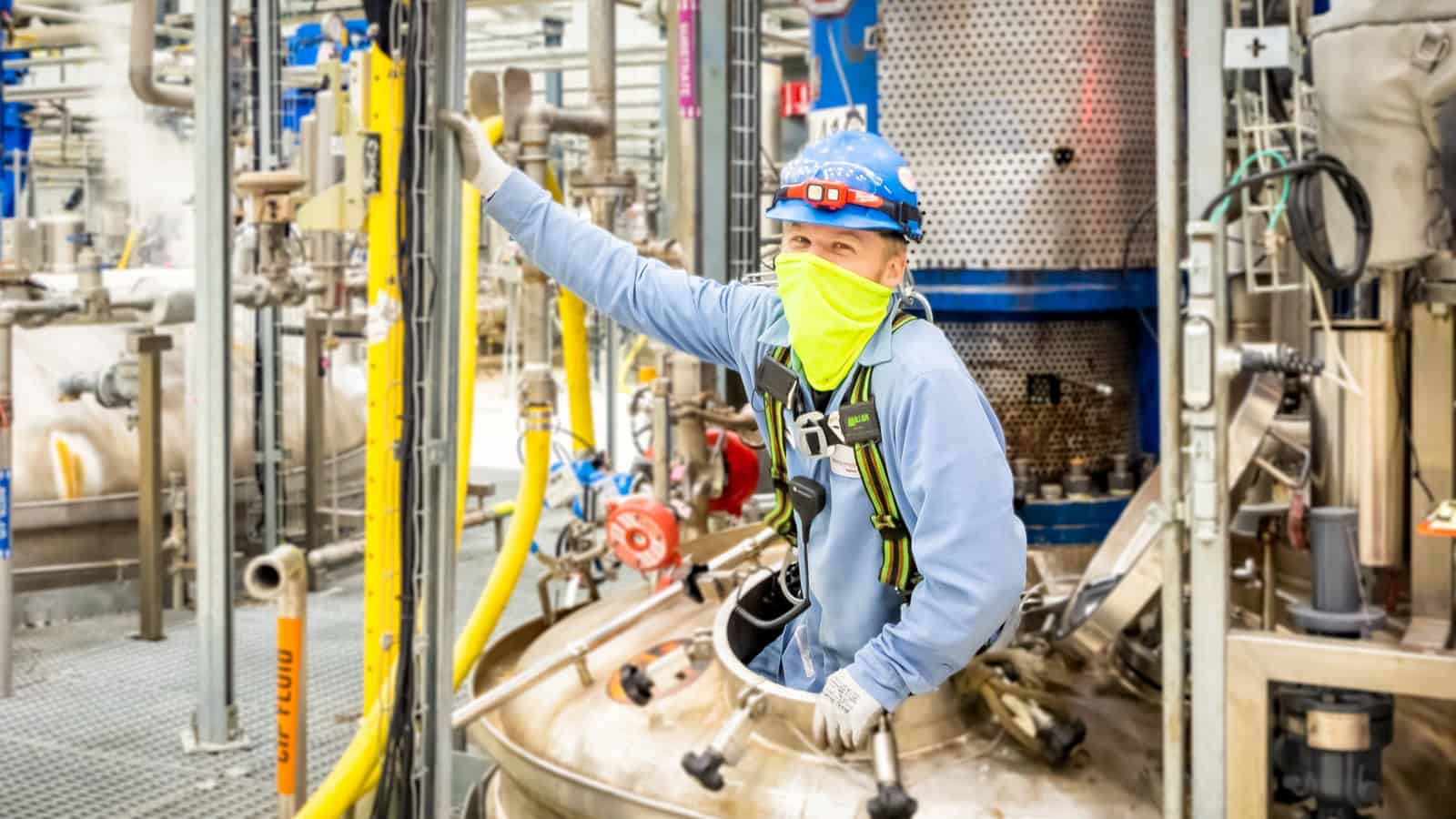Sylvamo Supports Healthy Forest Ecosystems

With a name that means “love of forests,” Sylvamo has a built-in dedication to sustainability. And the Memphis, Tennessee–based paper company, which spun off from International Paper in 2021, lives up to its moniker.
A holistic approach: “We use the whole tree in the manufacturing of our products,” Sylvamo Chief Sustainability Officer James McDonald told the NAM. “We use the fiber from the wood to make our paper, and all the residuals—think of the sticky stuff in trees—we capture and use to generate energy.”
- This process supplies the company with approximately 85% of its global energy needs, according to McDonald.
Planting the world: Sylvamo, which produces well-known brands like Hammermill, Accent Opaque, Springhill and HP Papers, is committed to restoring and protecting forests worldwide.
- “Our entire business depends on the sustainability of forests,” McDonald said. “It turns out your third-grade science teacher was right—photosynthesis does work. The more trees we grow, the more we can clean the air and protect the environment.”
Big ambitions: Sylvamo has conserved, enhanced or restored more than 37,000 acres of forestland to date. It has set the lofty goal of reaching 250,000 acres of forestland by 2030.
- To that end, the company is supporting the Nature Conservancy’s work to create a healthy, resilient and connected Appalachian landscape in the U.S. and the World Wildlife Fund’s work to restore Brazil’s Atlantic Forest, while also working with individual landowners to enhance forest management practices in France.
Diverse sources: Sylvamo primarily sources local fiber to manufacture its products in Europe, Latin America and North America, a strategy that enables a smaller environmental footprint, McDonald said.
- “Most of the fiber is sourced very close to [each] mill, which supports our low-cost assets in each region and this global footprint advantage in those markets,” he added.
GHG goal: The company is committed to a greenhouse gas reduction goal of 35% from a 2019 baseline across all three emissions scopes, an ambitious goal that demonstrates a commitment to improve Sylvamo’s climate impact continuously, according to McDonald.
- A quick refresher: Scope 1 refers to direct emissions, Scope 2 to indirect emissions associated with the purchase of power and Scope 3 to indirect emissions produced by a company’s value chain.
- Above all, “we try to be efficient with the energy we do use so that we can use less to produce our products,” McDonald told us.
A vital commodity: Paper and paper products continue to “play a crucial role every day in people’s lives,” said McDonald—and they are some of the world’s most recyclable materials.
- Some 68% of paper in the U.S. was recovered in 2022. In some parts of Brazil, the percentage is about 60%, and in Europe, it’s near 80%, he added.
The last word: “Just think about it: We use paper for education, communication, entertainment and more,” McDonald pointed out. “Our product plays a huge role in society and has a good lifecycle story.”
How Henkel Is Exceeding Sustainability Goals

If you ask Henkel how it managed to cut its worldwide carbon footprint in half a few years ago, its leaders will gladly let you in on the secret: there isn’t one.
The impressive reduction is down to common sense and good old-fashioned effort.
Putting in the work: “One focus is on our own sites and production, and we’re continuously working on this,” said Henkel North America President Pernille Lind Olsen.
- By the end of 2023, the global adhesives and consumer brands manufacturer had fully converted 19 of its worldwide facilities to run on renewable electricity sources, a feat it achieved through on-site energy production including wind and solar, as well as direct purchase of green power from local utility companies.
- Henkel also entered into virtual power purchase agreements, financial transactions through which it buys renewable energy credits that serve to decarbonize geographically diffuse operations.
- In addition, the company hired energy-efficiency consultants to come into its most energy-intensive plants and tell it where and how to cut down on resource use and waste.
Exceeding goals: Thanks to these efforts, Henkel has reduced its carbon footprint by 61%, heading toward its 2025 goal to slash its carbon footprint (from a 2010 baseline) by 65%.
Sustainable personal care: Henkel is always on the lookout for ways to increase the sustainability of its 30-plus beauty and personal care brands, which include Purex and All laundry detergents and Schwarzkopf hair cosmetics.
- For example, the company keeps a formulation database of its more than 200,000 products. In the database, each formula is assigned a compact sustainability report, making it possible for the company to compare profiles “to optimize the impact of our footprint,” Olsen told us.
- Last March, Henkel reformulated and repackaged its Dial body washes in order to use bottles made from 100% recycled plastic.
- Henkel has also reduced the amount of virgin plastic in the bottles of Persil laundry detergent, replacing it with recycled content.
Less to landfills: Henkel isn’t done setting goals. It’s now aiming to send exactly zero waste to landfills by 2030.
- And it’s making progress: through partnerships with local waste management companies, in 2023 Henkel converted three of its U.S. sites to redirection rather than disposal of production waste from their operations—that is, they have established processes to keep materials out of landfills. Some of the ways they do this are to recycle or reuse items rather than throw them away.
- Meanwhile, some 82% of Henkel’s global facilities had already been doing the same.
A symbiotic relationship: Pursuing sustainable methods is both a business and moral imperative for the company, which will celebrate 148 years of business in September.
- “As climate change becomes a bigger challenge for everyone to tackle, it becomes increasingly necessary to prioritize sustainability as part of your business,” Olsen said.
- “And sustainability is good business for us and our customers. There’s a price benefit there. For example, when you lower the temperatures or reduce process steps at our industrial process customers, energy and material usage will be lower, maintenance of the equipment becomes less frequent and you can run longer without stopping, which saves money.”
Stronger together: “To make sure the planet’s resources can sustain us and our kids for generations, we will need to tackle the sustainability challenge of how to use less energy, fewer materials, less water,” Olsen concluded.
- “That’s a big challenge, and I’m a firm believer that it needs to be tackled collaboratively. I believe the business leaders of today play a decisive role in how we will do that.”
This story has been edited.
Emerson Finds Energy in Sustainability

When Emerson’s first-ever Chief Sustainability Officer Mike Train talks about his company, his enthusiasm shines through.
- “What we do to enable our customers is huge,” said Train. “We have an important role to play—and I get a lot of energy out of that.”
An aggressive push: The technology and engineering company, headquartered in St. Louis, Missouri, has been making big moves in sustainability over the past few years—beginning with a goal in 2018 to reduce some of its greenhouse gas intensity by 20% over 10 years.
- At the time, the goal was ambitious, and the company wasn’t quite sure how it would achieve it. But employees banded together and pulled it off.
- “We actually achieved the goal in 2022—six years early,” said Train. “But the act of putting out a goal and not knowing exactly how we’d solve for it … has been driving the culture of our company. Our employees are proud we put it out there, proud to have participated, and it’s activated thousands of people to get excited about what we’re doing.”
An inclusive approach: Since then, the company has applied a range of tactics. From “energy treasure hunts,” in which teams search for energy waste in facilities, to renewable energy procurement and collaborations with supply chain partners, Emerson is finding interesting and inclusive ways to make an impact.
- The company has gone from getting 3% of its power from renewables to getting to 49% from those sources. And it now has a commitment to use 100% renewable energy by 2030.
- Emerson is setting other big goals, too, from net-zero operations by 2030 to a zero-waste-to-landfill pledge, along with other water and biodiversity actions.
An effective framework: The company has a three-part approach to its sustainability practices.
- Greening Of Emerson involves the actions Emerson is taking to reduce its own footprint by minimizing waste and engaging its supply chain.
- Greening By Emerson involves the company’s activities to help a wide range of manufacturing customers improve their own sustainability, often through Emerson’s automation portfolio and expertise. This, according to Train, is where Emerson has its biggest opportunity for impact.
- Greening With Emerson refers to the company’s work with government and research organizations on policy and innovation, offering technical expertise and manufacturing perspective to help drive action.
A group effort: Train has seen the company coalesce around these goals—from the sustainability team he works with every day (“they bring a lot of energy and passion to what we’re doing”) to the rest of the company’s 74,000-person workforce.
- “The fun part of sustainability is everyone is learning it together,” Train continued. “You’re allowed and encouraged to borrow ideas from each other, so the collaborative part of sustainability is an awful lot of fun.”
Senior Sinema Advisor Chris Phalen to Lead NAM’s Energy and Environment Policy Team
Washington, D.C. – The National Association of Manufacturers announced that Chris Phalen, most recently a senior policy advisor to Sen. Kyrsten Sinema (I-AZ), is joining the NAM as vice president of domestic policy:
“As the NAM continues to be at the forefront of energy policy debates before Congress and federal agencies, Chris’ depth of experience and record of accomplishments will help us further stand out and influence outcomes in support of an all-of-the-above energy policy,” said NAM President and CEO Jay Timmons. “Manufacturers are facing a political war on energy. Permitting reform, securing critical mineral supply chains and regulatory barriers slowing the clean energy transition are just some of the defining issues impacting our industry’s ability to create well-paying jobs, as well as our nation’s energy security. Chris will help us steer policymakers in the right direction.”
Sen. Sinema has been a key figure in negotiating solutions to manufacturing priorities, and as her advisor, Phalen was a leader in negotiating and implementing critical energy policies and in writing the permitting reform provisions in the Fiscal Responsibility Act and key sections of the Infrastructure Investment and Jobs Act, including all provisions on energy and mining. Phalen brings a record of active engagement with key agencies, including the Environmental Protection Agency, the Department of Energy, the Department of the Interior, the Department of Agriculture, the White House Council on Environmental Quality, the Federal Energy Regulatory Commission and the Federal Permitting Improvement Steering Council. Phalen previously worked for leading energy companies, including Chevron and the Rio Tinto Group.
Timmons added, “Manufacturers are leading the global effort to fight climate change and develop the technologies needed to achieve climate goals. With Chris’ keen insight into these important policy discussions, the NAM will become an even more effective voice for the 13 million people who make things in America.”
Phalen will report to NAM Managing Vice President of Policy Chris Netram and work closely with NAM Executive Vice President Erin Streeter. His policy portfolio will include sustainability, climate, permitting reform, labor, transportation and infrastructure, and he will work alongside NAM Vice President of Domestic Policy Charles Crain and NAM Vice President of International Policy Andrea Durkin.
-NAM-
The National Association of Manufacturers is the largest manufacturing association in the United States, representing small and large manufacturers in every industrial sector and in all 50 states. Manufacturing employs nearly 13 million men and women, contributes $2.89 trillion to the U.S. economy annually and accounts for 53% of private-sector research and development. The NAM is the powerful voice of the manufacturing community and the leading advocate for a policy agenda that helps manufacturers compete in the global economy and create jobs across the United States. For more information about the NAM or to follow us on Twitter and Facebook, please visit www.nam.org.
NAM, Partners File Opening Brief in Suit Against EPA

On Thursday, the NAM, joined by other business groups, filed the opening brief in their pending lawsuit against the Environmental Protection Agency.
What’s going on: In March, the groups petitioned the D.C. Circuit to review the EPA’s reconsideration of the National Ambient Air Quality Standards for fine particulate matter (or PM2.5), which lowers the allowable level to 9 micrograms per cubic meter of air from 12, a 25% reduction. The agency handed down the final, tightened rule in February.
- In their brief, the coalition argues that the EPA lacks the authority under the Clean Air Act—the law that authorizes it to establish the NAAQS—to “reconsider” a decision made in 2020 to not lower the PM2.5 standard; that the agency failed to take into account the cost and feasibility of a tightened standard; and that it failed to give a “reasoned explanation for key aspects of its decision.”
- The groups participating in the suit with the NAM are the U.S. Chamber of Commerce, the American Chemistry Council, the American Petroleum Institute, the American Forest & Paper Association, the American Wood Council, the National Mining Association and the Portland Cement Association.
Why it’s important: The tighter NAAQS rule could result in many parts of the U.S. being designated as in nonattainment, which would trigger significant new costs for manufacturers and others attempting to obtain air permits in those locations.
- Many of these areas “are indisputably handicapped in their ability to reduce emissions to meet the new NAAQS” due to factors beyond municipalities’ and manufacturers’ control (i.e., wildfires, which affect most of the contiguous U.S. at some point each year).
- The new rule could also prevent manufacturers from building or modifying facilities in certain areas, undermining the Biden administration’s own “Investing in America” agenda, as it would stifle investment in manufacturing and kill—not create—well-paying manufacturing jobs.
What should be done: The rule should be vacated as soon as possible, the groups told the court.
Novonesis Lets Nature Guide Sustainability Plans

When it comes to good environmental stewardship, Novonesis takes its cue from the natural world itself.
“We are inherently sustainable because we draw from nature,” said Novonesis Senior Vice President of Planetary Health Biosolutions Rene Garza. “As biology matures, we find that nature has evolved to be an efficient utilizer of every single resource out there.”
Back to basics: It’s the perfect model for the newly formed Lyngby, Denmark–headquartered biosolutions firm, the product of a January merger between two Danish legacy companies: enzyme and microbial technology firm Novozymes and bioscience supplier Chr. Hansen.
- The portfolio of Novonesis—which is a combination of the Greek words for “new” and “beginning”—includes enzymes, microbes, novel vitamins and other naturally derived offerings.
- The business has customers across more than 30 industries: food and beverages, animal health and nutrition, energy, fine chemicals, dietary supplements, household care, plastics, plant health and more.
An early adopter: Legacy firm Novozymes set its sights on sustainable business practices more than two decades ago. In 2002, it became the first company in the world to publish a triple bottom-line integrated report.
- “We recognized early on that resources are finite, and the need to do more with less is part of ensuring a better quality of life,” Garza said of the company’s decision to undertake the annual report, a method of stocktaking on sustainability activities using three “bottom lines”: profit, people and planet. “We realized we’re not just here to generate money, but also to create an impact on society and our environment.”
Big goals: That’s why Novonesis has set lofty aims for itself (and is meeting them).
- Firmwide targets include carbon net neutrality by 2050, as well as a 75% reduction in emissions from its own operations and a 35% reduction in emissions from its supply chain by 2030.
- How is it doing all this? Innovation and persistence, according to Garza. “We want to improve our efficiency by as much as we can, and we do this by making improvement to our hardware—pump replacements, reengineering [of] our microorganisms. We also source renewable energy.”
- In fact, Novonesis is on track to source 100% of its energy from renewables by next year. Between 2018 and 2022, it reduced absolute emissions by 63% while increasing revenue.
Water, too: Novonesis knows how important water use is in the overall sustainability picture.
- The company is piloting a reverse-osmosis filtration system at its North America headquarters in Franklinton, North Carolina, that lets it recycle and reuse water. The program, scheduled for full operationality by next year, is going so well there are plans to replicate it at other Novonesis facilities worldwide.
- And at the company headquarters in Denmark, “we have been able to recycle 58 million liters [of water]—the equivalent of 23 Olympic-size swimming pools,” Garza reported.
What government can do: Novonesis and other manufacturers are making great strides in sustainability, but having the right policies in place at the federal level would make it easier for them to do more with less, Garza continued.
- “We need regulatory reform,” he told the NAM. “Federal regulations, if done well, really can drive innovation, particularly in biotechnology. … The government should [also] invest in pilot and demo scale fermentation capacity to allow startups to scale up.”
- The U.S. has the largest concentration of startup companies in the world, he went on, but there is now a “valley of death” between discovery and commercialization of innovations in biology, which federal funding could help remove.
- Finally, manufacturing in the U.S. needs the reinstatement of pro-growth policies from the 2017 Tax Cuts and Jobs Act, including 100% expensing for research and development costs and accelerated depreciation for capital investments.
Stakeholder education: Getting more people aboard the sustainability train is doable—but it will require continued education campaigns.
- “We need long-term thinking [and] to encourage stakeholders to prioritize the long-term over short-term gains,” Garza said. “Sustainability is about balancing immediate and future needs.”
EPA’s Power Plant Rule Is Unachievable Without Substantial Permitting Reform
America’s Energy Security Is Threatened
Washington, D.C. – Following the release of the Environmental Protection Agency’s new regulations on greenhouse gas emissions standards for certain power plants, National Association of Manufacturers President and CEO Jay Timmons released the following statement:
“Manufacturers appreciate the EPA removing existing gas plants from its new regulation, following manufacturers’ warnings about the initial proposal. However, the rest of the rule causes serious concern because Congress and the president have not enacted permitting reform—making it impossible to achieve the EPA’s highly aspirational mandates. We call on Congress to get serious by enacting significant and meaningful permitting reform this year. That is essential to ramping up the use of renewables, carbon capture, hydrogen and nuclear, for example, to meet future demand.
“The final rule threatens grid reliability because of the unrealistic timeline for power plants to adopt technologies within the next 10 years that have yet to even be proven at scale. Our nation should be doing everything possible to make sure our families, businesses and manufacturers have a modern, strong and reliable electrical grid, especially at a time when global turmoil threatens our energy security. This new rule does the opposite, creating a threat to our national and economic security that literally could leave Americans in the dark and factories offline. In short, the EPA is rolling the dice with Americans’ electricity and therefore with President Biden’s manufacturing legacy.
“Our industry has made transformational investments in these technologies and clean energy solutions, and we are leading the way in their deployment. The EPA should be partnering with us—not undermining this progress. We will continue to press the administration to achieve a more balanced regulatory framework to help reach our climate goals.”
-NAM-
The National Association of Manufacturers is the largest manufacturing association in the United States, representing small and large manufacturers in every industrial sector and in all 50 states. Manufacturing employs nearly 13 million men and women, contributes $2.89 trillion to the U.S. economy annually and accounts for 53% of private-sector research and development. The NAM is the powerful voice of the manufacturing community and the leading advocate for a policy agenda that helps manufacturers compete in the global economy and create jobs across the United States. For more information about the NAM or to follow us on Twitter and Facebook, please visit www.nam.org.
Making the Business Case for Sustainability

Ecolab’s mission hasn’t changed much in more than 100 years. It’s still “bringing science to our customers in a way that drives performance, productivity and less water and energy use.”
- That’s according to Ecolab Chief Sustainability Officer Emilio Tenuta, who says being climate-minded is not only “the right thing to do,” but also at the core of the St. Paul, Minnesota–headquartered water, hygiene and infection-prevention company’s operating model.
A dual purpose: “We make the business case for why sustainability and [profitability] can go hand-in-hand when it comes to driving solutions,” Tenuta told us recently. “It’s why 48,000 Ecolab associates wake up every morning with the feeling, ‘We’re making a real difference in the world.’”
- Ecolab—which recently announced that 100% of its European operations are now powered by renewable energy sources—helps millions of customers worldwide reduce their environmental impact while promoting food safety, maintaining clean environments and optimizing resource use.
- “At Ecolab, we talk about eROI—Exponential Return on Investment,” Tenuta explained. “It’s about understanding that we have the ability to deliver on a business outcome—profitability—while also delivering an environmental impact.”
Don’t forget water: Often neglected in sustainability conversations, Tenuta said, is water. For a full picture of the effect of conservation and innovation efforts on climate, water needs to be factored in.
- “Sometimes we forget the role that water plays in addressing climate change,” he continued. Depending on the type of manufacturing, up to 75% of energy is driven by the water systems. You have to heat it, treat it, pump it, cool it. …Water doesn’t necessarily get the same headlines as climate, but if you follow the water, that’s going to have a lasting impact” on the environment, while also saving you money.
A holistic approach: In addition to being recognized regularly for its environmental stewardship, Ecolab is routinely named to most-ethical-company lists. That’s no accident; to the company, caring for the planet goes hand-in-hand with caring for people, Tenuta told the NAM.
- “Workplace quality is just [one way of] demonstrating a holistic approach to the world,” he said. “That’s how we think about it at Ecolab. It’s for us as a company but it’s also for society as a whole.”
A sustainable partnership: In furtherance of its financial and net-zero emissions goals, the firm recently partnered with Ford to electrify its service and sales vehicles.
- Ecolab—which has “a longstanding relationship dating back almost 100 years” with the automaker, according to Tenuta—has pledged to both halve emissions from its own operations and help its customers reduce their emissions by 6 million metric tonnes by 2030. “To get there, we need to implement initiatives like electrifying our fleet,” he said.
- Under the program, Ecolab will buy and deploy more than 1,000 Ford F-150 Lightning and Mustang Mach-E electric vehicles for its employees in California by 2025. The company will then move to electrify its entire North American sales and service fleet by 2030. “This allows us to support our associates so they can be more productive in their day-to-day work serving our customers and getting to net zero.”
Advice for manufacturers: Achieving sustainable operations doesn’t happen overnight—but undertaking the efforts to get there is well worth manufacturers’ time, Tenuta said.
- “Sustainability requires a multifaceted approach that considers all things: social, emotional, economic. It’s about in some ways taking a longer-term view of progress and opportunity. That can be challenging, but by elevating innovation and long-term commitment, companies can build a more sustainable future … and boost profitability.”
Making the Business Case for Sustainability

Ecolab’s mission hasn’t changed much in more than 100 years. It’s still “bringing science to our customers in a way that drives performance, productivity and less water and energy use.”
- That’s according to Ecolab Chief Sustainability Officer Emilio Tenuta, who says being climate-minded is not only “the right thing to do,” but also at the core of the St. Paul, Minnesota–headquartered water, hygiene and infection-prevention company’s operating model.
A dual purpose: “We make the business case for why sustainability and [profitability] can go hand-in-hand when it comes to driving solutions,” Tenuta told us recently. “It’s why 48,000 Ecolab associates wake up every morning with the feeling, ‘We’re making a real difference in the world.’”
- Ecolab—which recently announced that 100% of its European operations are now powered by renewable energy sources—helps millions of customers worldwide reduce their environmental impact while promoting food safety, maintaining clean environments and optimizing resource use.
- “At Ecolab, we talk about eROI—Exponential Return on Investment,” Tenuta explained. “It’s about understanding that we have the ability to deliver on a business outcome—profitability—while also delivering an environmental impact.”
Don’t forget water: Often neglected in sustainability conversations, Tenuta said, is water. For a full picture of the effect of conservation and innovation efforts on climate, water needs to be factored in.
- “Sometimes we forget the role that water plays in addressing climate change,” he continued. Depending on the type of manufacturing, up to 75% of energy is driven by the water systems. You have to heat it, treat it, pump it, cool it. …Water doesn’t necessarily get the same headlines as climate, but if you follow the water, that’s going to have a lasting impact” on the environment, while also saving you money.
A holistic approach: In addition to being recognized regularly for its environmental stewardship, Ecolab is routinely named to most-ethical-company lists. That’s no accident; to the company, caring for the planet goes hand-in-hand with caring for people, Tenuta told the NAM.
Read the full story here.
EPA Awards $20 Billion in “Green Bank” Funds

The EPA late last week awarded $20 billion to community development banks and nonprofit organizations to combat climate change in disadvantaged communities in the U.S., the Associated Press reports.
What’s going on: Money from the “green bank” initiative “could fund tens of thousands of eligible projects ranging from residential heat pumps and other energy-efficient home improvements to larger-scale projects such as electric vehicle charging stations and community cooling centers.”
- Previously called the Greenhouse Gas Reduction Fund, the $27 billion “green bank” overseeing the grants was created by the 2022 Inflation Reduction Act. Its aim is “to reduce climate and air pollution and mobilize public and private capital in the communities that need it most.”
Where the money went: At least $14 billion of the funding is reserved for low-income and rural areas, neighborhoods of color and communities with shuttered coal mines, among other locations.
- One of the bank’s funds is the National Clean Investment Fund. Grants from that pot include nearly $7 billion to help consumers, schools and small businesses and farms, $5 billion to “leverage the existing and growing national network of green banks” and $2 billion for decarbonized, affordable housing, according to Axios.
- Another fund, the $6 billion Clean Communities Investment Accelerator, is for centers that offer technical help and lending to clean-technology projects.
How it works: “Recipients committed to spending $7 in private sector funding for each $1 from the federal investment money, to ‘reduce or avoid’ 40 million metric tons of carbon dioxide each year and earmark 70% of the money for disadvantaged and low-income communities. These groups are often passed over by commercial banks and investors yet are disproportionately impacted by climate change.”
